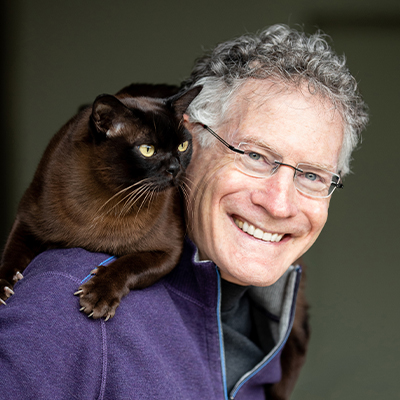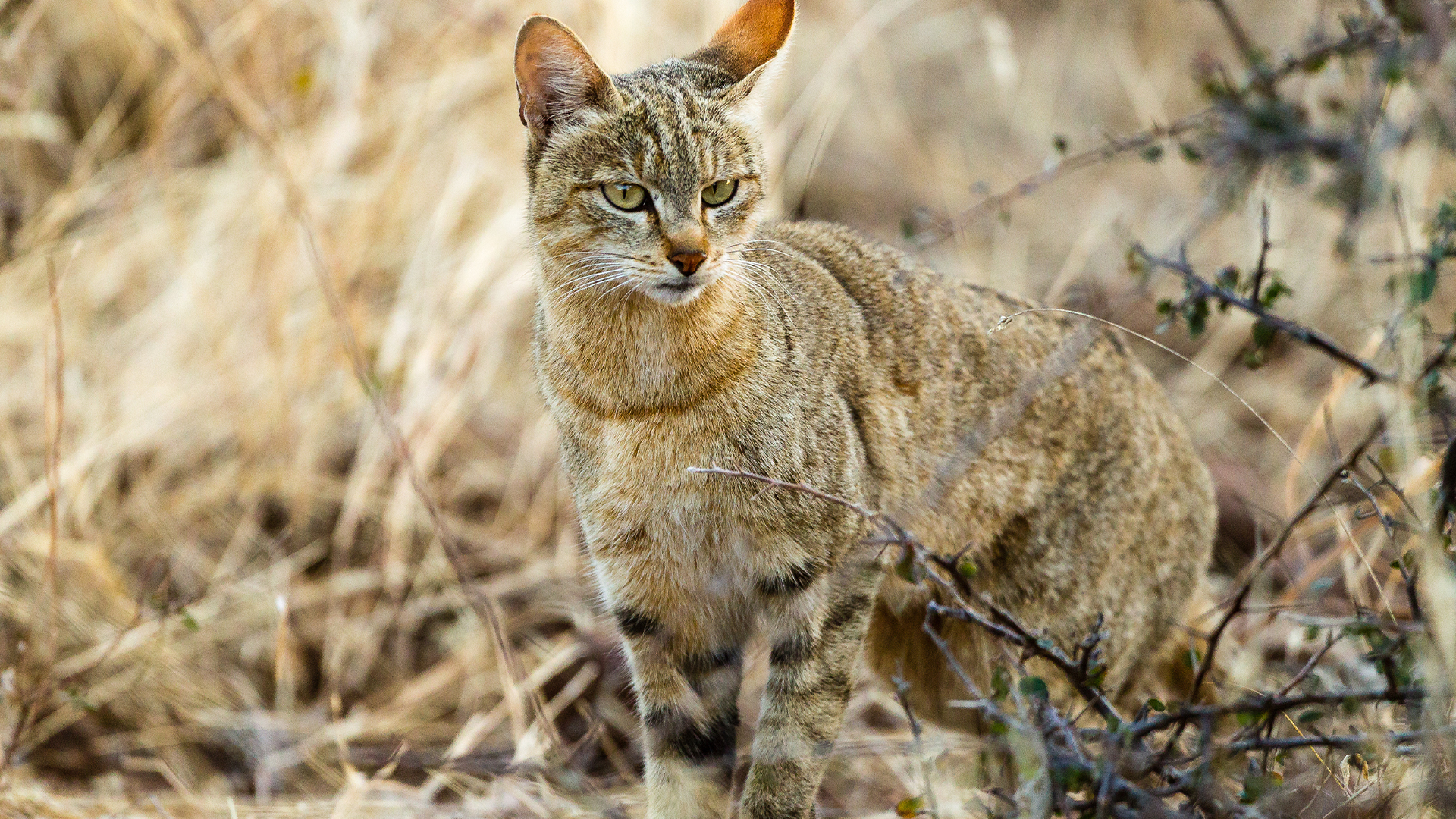What is the difference between a pet cat and a wildcat?
Here's how cats first finagled their way into human hearts and homes thousands of years ago.

Most domesticated animals look very different from their wild ancestors. Think of the differences between dogs and wolves or pigs and wild boar. But not our feline companions. Every domestic cat — the lovable fur babies of the pet world — is descended from the African wildcat, a species so similar to our household pets that if you saw one from your kitchen window, your first thought would be "Look at that beautiful cat in the backyard," not "How'd that African wildcat get to New Jersey?"
Of course, not all pet kitties are mirror images of these wild felines. Some house cats sport myriad colors, patterns and hair textures not seen in wildcats; others have distinctive physical features, like munchkins' short legs, Siameses' elongated faces or Persians' lack of muzzle.
Yet many domestics appear basically indistinguishable from wildcats. In fact, only 13 genes have been changed by natural selection during the domestication process. By contrast, almost three times as many genes changed during the descent of dogs from wolves.
So, how different are domestic cats from wildcats?
There are only two ways to indisputably identify a wildcat. You can measure the size of its brain — house cats, like other domestic animals, have evolved reductions in the parts of the brain associated with aggression, fear and overall reactivity. Or you can measure the length of its intestines — longer in domestic cats to digest vegetable-based food provided by or scavenged from humans.
The most significant evolutionary changes during cat domestication involve their social behavior. The common view that domestic cats are aloof loners couldn't be further from the truth. When lots of domestic cats live together — in places where humans provide copious amounts of food — they form social groups very similar to lion prides. Composed of related females, these cats are very friendly — grooming, playing with and lying on top of each other, nursing each other's kittens, even serving as midwives during birth. This gregariousness is unlike the behavior of the African wildcat or any other feline species…except the King of the Jungle.
Related: Is it safe for cats to drink milk?
Get the world’s most fascinating discoveries delivered straight to your inbox.
The evolutionary similarity of these two species extends to how they greet each other. To signal friendly intentions, an approaching cat raises its tail straight up, a trait shared with lions and no other feline species. As anyone who has lived with a cat knows, they use this "I want to be friends" message toward people as well, indicating that they include us in their social circle.
Clearly, the few evolutionary changes the domestic cat has made have been the right ones to wangle their way into people's hearts and homes. How did they do it? I explored this question in my book "The Cat's Meow: How Cats Evolved from the Savanna to Your Sofa."
Why the African wildcat?
Big cats — like lions, tigers and pumas — are the attention-grabbing celebrities of the feline world. But of the 41 species of wild felines, the vast majority are about the size of a house cat. Few people have heard of the black-footed cat or the Borneo bay cat, much less the kodkod, oncilla or marbled cat. Clearly, the little-cat side of the feline family needs a better PR agent.
In theory, any of these species could have been the progenitor of the domestic cat, but recent DNA studies demonstrate unequivocally that today's house cats arose from the African wildcat — specifically, the North African subspecies, Felis silvestris lybica.
Given the profusion of little pusses, why was the North African wildcat the one to give rise to our household companions?
In short, it was the right species in the right place at the right time. Civilization began in the Fertile Crescent about 10,000 years ago, when people first settled into villages and started growing food.
This area — spanning parts of modern-day Egypt, Turkey, Syria, Iran and more — is home to numerous small cats, including the caracal, serval, jungle cat and sand cat. But of these, the African wildcat is the one that to this day enters villages and can be found around humans.
African wildcats are among the friendliest of feline species; raised gently, they can make affectionate companions. In contrast, despite the most tender attention, their close relative the European wildcat grows up to be hellaciously mean.
Given these tendencies, it's easy to envision what likely happened. People settled down and started raising crops, storing the excess for lean times. These granaries led to rodent population explosions. Some African wildcats — those with the least fear of humans — took advantage of this bounty and started hanging around. People saw the benefit of their presence and treated the cats kindly, perhaps giving them shelter or food. The boldest cats entered huts and perhaps allowed themselves to be petted — kittens are adorable! — and, voilà, the domestic cat was born.
Related: Why do so many cats have white 'socks' on their paws?
Where exactly domestication occurred — if it was a single place and not simultaneously throughout the entire region — is unclear. But tomb paintings and sculptures show that by 3,500 years ago, domestic cats lived in Egypt. Genetic analysis — including DNA from Egyptian cat mummies — and archaeological data chart the feline diaspora. They moved northward through Europe (and ultimately to North America), south deeper into Africa and eastward to Asia. Ancient DNA even demonstrates that Vikings played a role in spreading felines far and wide.
Evolution of a master meowing manipulator
Household cats are quite vocal to their human companions, using different meows to communicate different messages. Unlike the tail-up display, however, this is not an example of their treating us as part of their clan. Quite the contrary, cats rarely meow to one another.
The sound of these meows has evolved during domestication to more effectively communicate with us. Listeners rate the wildcat's call as more urgent and demanding ("Mee‑O‑O‑O‑O‑O‑W!") compared with the domestic cat's more pleasing ("MEE‑ow"). Scientists suggest that these shorter, higher-pitched sounds are more pleasing to our auditory system, perhaps because young humans have high-pitched voices, and domestic cats have evolved accordingly to curry human favor.
Cats similarly manipulate people with their purrs. When they want something — picture a cat rubbing against your legs in the kitchen while you open a can of wet food — they purr extra loudly. And this purr is not the agreeable thrumming of a content cat, but an insistent chainsaw br-rr-oom demanding attention.
Scientists digitally compared the spectral qualities of the two types of purrs and discovered that the major difference is that the insistent purr includes a component very similar to the sound of a human baby crying. People, of course, are innately attuned to this sound, and cats have evolved to take advantage of this sensitivity to get our attention.
Of course, that won't surprise anyone who's lived with a cat. Although cats are very trainable — they're very food motivated — cats usually train us more than we train them. As the old saw goes, "Dogs have owners, cats have staff."
This edited article is republished from The Conversation under a Creative Commons license. Read the original article.

Jonathan Losos is an evolutionary biologist known for his research on how lizards rapidly evolve in response to changing environments. Recently, he has been asking similar questions about domestic cats, investigating where they came from, why they do what they do, and what the future may hold, topics that are explored in "The Cat’s Meow: How Cats Evolved from the Savanna to Your Sofa." Losos is the William H. Danforth distinguished university professor at Washington University and director of the Living Earth Collaborative, a partnership between Wash U., the Saint Louis Zoo and the Missouri Botanical Garden. He is a member of the National Academy of Sciences and the American Academy of Arts & Sciences and is the recipient of many awards.



